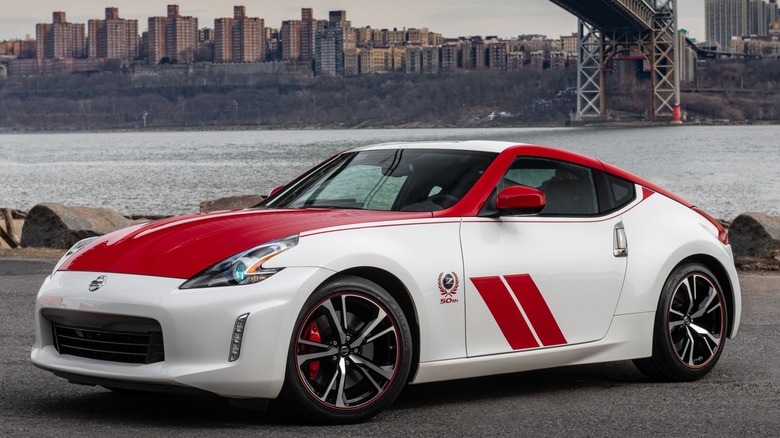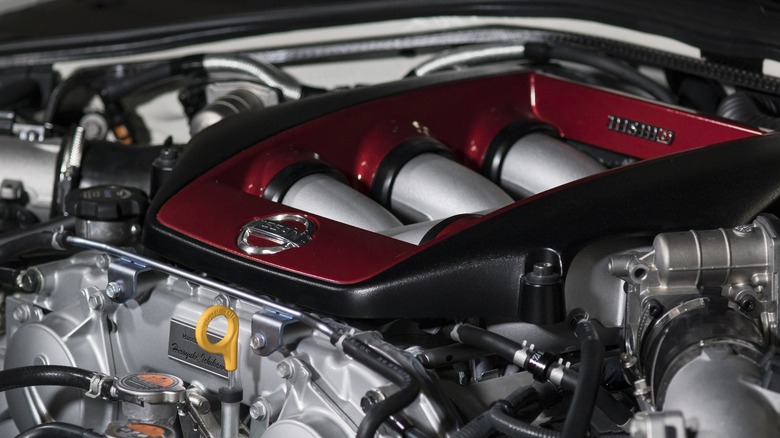VR38 Vs. VQ37: What's The Difference Between These Nissan Engines?
Nissan introduced the VQ37VHR V6 to the world at the New York International Auto Show in 2007 in the all-new 2008 Infiniti G37 Coupe, one of the best Infiniti cars of all time. The new engine built upon the success of Nissan's popular VQ engine platform with upgrades like Variable Valve Event and Lift (VVEL). Nissan's VVEL is similar to the Variable Valve Timing (VVT) or Variable Valve Timing and Lift Electronic Control (i-VTEC) employed by other automakers.
The same year, Nissan debuted the R35 GT-R with its all-new VR38DETT V6, available through Nissan High Performance Centers throughout Japan. The VR38 produces incredible horsepower by combining design elements from Nissan's proven line of VQ engines, new VVEL technology, electronic port fuel injection, and twin turbochargers.
The letters at the end of the VR38 name give clues to the engine's make-up. D stands for dual overhead camshafts, E represents its electronic port fuel Injection, and the twin-Ts at the end are an almost visual representation of the twin turbochargers providing the boost pressures to make its generous power. In similar fashion, the VHR at the end of the VQ37 name designates the use of VVEL and its capacity for high revolutions and high response carried over from VQ25HR and VQ35HR engines.
Nissan's VR38DETT has slightly more displacement than the VQ37VHR
These Nissan V6 engines also provide clues to their displacement with the numbers they contain. You could probably guess that the VQ37VHR has a 3.7-liter displacement, while the VR38DETT engine is slightly larger at 3.8 liters.
The two six-cylinder engines use aluminum blocks with the same cylinder bore diameter measuring 95.5 millimeters (3.76 inches). However, the VR38DETT features a crankshaft with a longer 88.4 millimeter (3.480 inch) stroke compared to the VQ37VHR crankshaft's 86 millimeters (3.386 inch) stroke length.
Other differences related to the internal workings of these engines include compression ratios and cylinder wall construction. The VQ37VHR features mirror bore cylinder coatings to reduce weight and friction, while the VR38DETT uses plasma-sprayed cylinder bores. Compression ratios also differ, with the VR38 featuring a 9.0:1 ratio compared to the VQ37 with its higher 11.0:1 compression.
The VR38DETT provides more power than the VQ37VHR
It'll come as no surprise that the larger VR38 with its twin turbochargers is more powerful than the naturally aspirated VQ37VHR, but the amount of difference might get your attention. The base VQ37VHR in the 2020 Nissan 370Z 50th Anniversary Editions Roadster made 332 hp at 7,000 rpm with 270 lb-ft of torque at 5,200 rpm. Ahead of its final model year, the 2024 Nissan GT-R with the VR38DETT aboard is rated at 565 hp at 6,800 rpm and 467 lb-ft of torque at 5,800 rpm.
Like other automakers' performance models, Nissan's NISMO (Nissan Motorsports) branded models produce more power. The final iteration of the NISMO 370Z for 2020 had its VQ37VHR V6 tuned to produce 350 hp at 7,400 rpm with 276 lb-ft of torque at 5,200 rpm. The 2024 Nissan NISMO GT-R on the other hand makes 600 hp at 6,800 rpm and 481 lb-ft of torque at 3,600 rpm.

